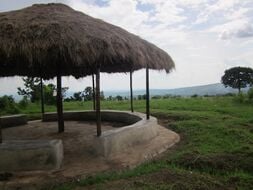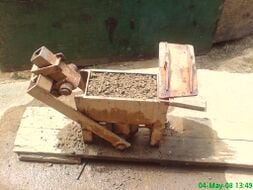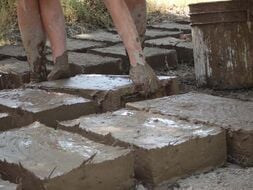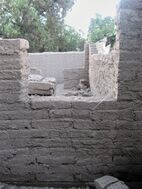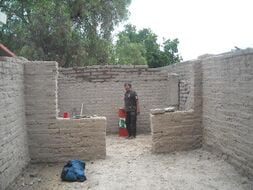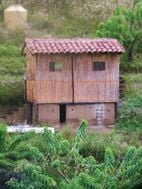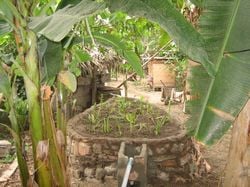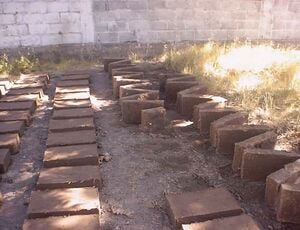
Adobe or Loam is a type of earthen construction composed, like cobb, of sand, clay, fiber (usually straw) and often other organic ingredients. The adobe mixture is shaped into bricks using adoberas (wooden frames) and then dried in the sun. Adobe structures are extremely durable, with many very old structures still in use (e.g. kasbahs in morocco[1]). They also regulate temperature due to their high thermal mass, which is very useful in climates with high diurnal temperature swings.
Adobe (or Loam) contains:
- Clay - under 0.002 µm
- Silt - 0.002 µm to 0.06 µm
- Sand - 2 µm
- Gravel - 100 µm
Improvements[edit | edit source]
It is common to add straw or other fiber-like materials to improve the strengthness of the Adobe.
List of components that were already used[edit | edit source]
Clay, Lime (around 5% maximum), Gipsum (around 5% maximum - use it only inside and in places without a lot of humidity), Faecal matter, Casein, Whey, Soap, Starch, Oils (such as Linseed oil. Apply it on dried adobe, not mix it in), Reisins, Waxes, Ash, Soda, Salt, Pigments, Sand, Gravel, Straw, Hemp, Hairs, Pinneadles, Coconut-fibers, Woodchips, Paper, Reed.
Hay is usualy not used because it tends to increase the chances of mold.
Things worth to mention[edit | edit source]
- All organic materials have to be mixed in in dry stage
- Every Earth is different - always make tests to see what works best
Adobe Bricks (How To Make Them)[edit | edit source]

This page provides detailed instructions for making adobe bricks. It covers the equipment and materials required, as well as step-by-step instructions and frequently asked questions (FAQs). If you're interested in making your own adobe bricks, this page is a great place to start.
Other Building Methods[edit | edit source]
Dangers[edit | edit source]
Earthquakes are a big thread to adobe constructions. In 2003, a earthquake destroyed huge parts of the city of bam in iran, which was build mainly with adobe. According to wikipedia at least 34'000 people died and more than 200'000 were injured. therefore it is not recommended to build houses only with bricks. there are multiple ways to improve the structure and strengthness (such as geomesh) but the best way is to used a solid structure such as wood-frames and discuss it with professional bricklayers, carpenters or architects.
Another danger is Radon which naturaly occurs in the earth. if the used adobe contains radon, it continuously evaporates and residents can get sicker and sicker. It is recommended to do a radon-test of the adobe, before start.[1]
Related projects[edit | edit source]
External links[edit | edit source]
- Wikipedia:Adobe
- Wikipedia:Loam
- wikiHow:Build an Adobe Wall
- networkearth - This site is loaded with the history, politics and techniques of many types of natural building.
- ABCs of making Adobe Bricks - Brief and could use some revision, but a good model of concise presentation.
- Earthquake resistant construction of Adobe Buildings: A Tutorial funded by the Earthquake Engineering Research Institute and hosted by the amazing world-housing database.
- Pequals.com Adobe Box Two girls, two adoberas (adobe forms), one big, adobe box. Renée and Kendra construct an adobe box in an attempt to hold water as an alternative to the plastic linings for ponds and gray water marshes.
- kleiwerks - Awesome natural-building teaching organization.
